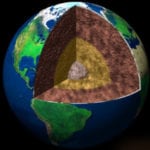 Miscellaneous
Miscellaneous  Miscellaneous
Miscellaneous  History
History 10 Great Escapes That Ended Right Back in Captivity
 Weird Stuff
Weird Stuff 10 Fascinating Things You Might Not Know About Spiders
 Food
Food 10 Everyday Foods You Didn’t Know Were Invented by the U.S. Military
 History
History 10 Odd Things Colonial Americans Kept at Home
 Weird Stuff
Weird Stuff 10 Superstitious Beliefs That Once Consumed Entire Cultures
 History
History 10 Bizarre Friendly Fire Incidents in Military History
 Technology
Technology 10 Modern Technologies That Accidentally Imitate Ancient Magic
 Mysteries
Mysteries 10 Mysteries of the Human Genome
 Weird Stuff
Weird Stuff 10 Things So Rare They’ve Only Been Found Once
 Miscellaneous
Miscellaneous 10 of History’s Most Bell-Ringing Finishing Moves
 History
History 10 Great Escapes That Ended Right Back in Captivity
 Weird Stuff
Weird Stuff 10 Fascinating Things You Might Not Know About Spiders
Who's Behind Listverse?

Jamie Frater
Head Editor
Jamie founded Listverse due to an insatiable desire to share fascinating, obscure, and bizarre facts. He has been a guest speaker on numerous national radio and television stations and is a five time published author.
More About Us Food
Food 10 Everyday Foods You Didn’t Know Were Invented by the U.S. Military
 History
History 10 Odd Things Colonial Americans Kept at Home
 Weird Stuff
Weird Stuff 10 Superstitious Beliefs That Once Consumed Entire Cultures
 History
History 10 Bizarre Friendly Fire Incidents in Military History
 Technology
Technology 10 Modern Technologies That Accidentally Imitate Ancient Magic
 Mysteries
Mysteries 10 Mysteries of the Human Genome
 Weird Stuff
Weird Stuff 10 Things So Rare They’ve Only Been Found Once
10 Animals Known For Gigantic Swarms
Is there anything more terrifying on Earth than legions, throngs, hordes of bugs? We have many names for them and most of them are pejorative—vermin, beasties, no-see-ums, creepy crawlies.
You have to admire their simplicity. They’re hundreds, thousands of times smaller than we are, yet when they gather in vast numbers, human beings find themselves seriously outgunned.
10 The Miracle Of The Gulls

This legend is one of the most famous of Mormon lore, and tells of a “Biblical” plague of crickets, now called Mormon crickets, that swept over the Great Salt Lake area in 1848. That was the year in which Brigham Young led the Mormon pioneers into Utah, and after a mild winter they looked forward to a very fruitful harvest. Unfortunately, insect swarms could easily spell starvation, and the unseasonal warmth meant that spring and summer pests, from insects to snakes, had not been killed by the cold. Even large, dangerous animals such as cougars expand their territory in mild winters.
Mormon crickets are actually very large katydids. They are around 7.5 centimeters (3 in) long, capable of pinching but not truly biting, and are flightless, which makes their swarming even more impressive. They swarm quite frequently in the Southwest United States, but the 1848 swarm was possibly the worst in recorded history. The Mormons would have been doomed—should have been doomed—had it not been for an equally “Biblical” flock of seagulls. California seagulls populate the Great Salt Lake area, since the lake is large enough to support them. The legend is based on diary and newspaper accounts of the settlers, who claimed that while they lamented being powerless to stop the crickets, a gigantic flock of gulls arrived in the sky, brought by their prayers to God for deliverance, and descended and ate all the crickets.
9 Christmas Island’s Red Crab Migration

It is considered a wonder of the natural world. Every November, in time with the full moon, the Christmas Island red crabs migrate to the shore to lay their eggs, then migrate back to their burrows. The island is 135 square kilometers (52 sq mi), and estimates put the number of crabs between 43 and 100 million. If you’re afraid of an entire island covered in crabs, rest assured that it is 431 kilometers (268 mi) from any other landmass.
Almost no species of crab is harmless. The red crab averages an 11-centimeter (4.5 in) carapace, and its pincers are fully capable of cutting human skin. Once they’re on the move en masse, it is impossible to go among them without stepping on them or them crawling on you, and the island appears to bleed. Luckily for the crabs, the whole island is an Australian nature preserve, and no human traffic is permitted during the migration period. In recent years, the crabs’ numbers have been severely depleted, to the tune of 10–15 million, by the introduced, invasive “yellow crazy ant.”
8 The Oklahoma Cricket Swarm Of 2013
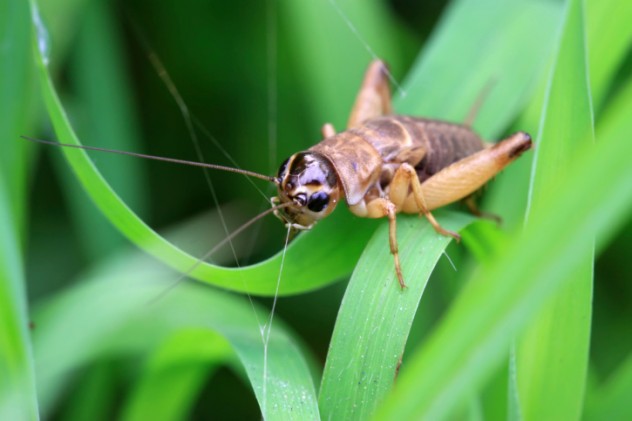
This past year has seen a particularly noisome infestation of Oklahoma and some border states by the common black field cricket. They cannot bite or sting, and many people keep them as pets or to feed to pets. They are also a popular fishing bait. But like all crickets, they eat plants, and modern American farmers spray their crops with various pesticides to combat insects. Swarms of insects are not as serious a problem in view of today’s science, but that does not solve the problem of a swarm of crickets dying from lack of food. If they can’t eat the crops, they die off fairly quickly, and the result is, as Richard Grantham described in Norman, Oklahoma, a plague of 10,000 dead crickets.
Ten thousand sounds like a large number, but the real figure has been estimated to be in the billions. Shoppers had to pass under crickets crawling on the ceilings of gas pumps awnings. The sound of people running was compared to running over crackers. Brian Jervis, a local expert, said that they first arrived in larger than usual numbers in September 2012, and seemed to die out through winter, only to show up again in even greater numbers in the summer. This was probably due to a very long dry spell through spring, ending with a long wet spell in June and July, which softened the ground and made egg-laying much easier. Residents were asked to turn off all outdoor lights at night, seal air conditioning vents if necessary, and go in and out of their houses very quickly. Even so, the stench of the carcasses became nauseating.
7 The Asian Giant Hornet Kills 42 In 2013
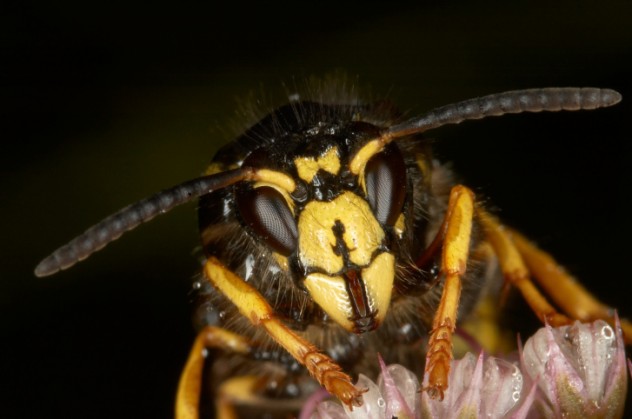
The Asian giant hornet is something of an Internet legend. Everyone has read about it, but unless you’re in China or Japan, chances are you haven’t seen one in person. Those who have maintain that they’re a living nightmare to behold. They are not particularly aggressive, but the Japanese subspecies, nicknamed the “sparrow bee,” is as large as a hummingbird, at 4 centimeters (1.5 in) in length. The external segment of the stinger is a quarter of an inch long. Their mandibles are large enough and strong enough to decapitate honeybees, which they do regularly in order to eat the larvae. Their response to any large animal’s intrusion near their nest is no worse than that of any other hornet or wasp, but their sting is known to be potentially fatal even for people without allergies.
The sting is said to be incredibly painful—it has been described as being like a nail heated up with a blowtorch and twisted into you. They can fly at 40 kilometers (25 mi) per hour and cover 100 kilometers (60 mi) in a day. Their venom contains mandaratoxin, a substance so potent that it can dissolve flesh, and the sting wounds are as large as bullet holes. From July to October 2013, a single outbreak killed 42 people in Shaanxi Province, China. In three separate cities, another 206 people were hospitalized. In sufficient quantities, the venom shuts down the kidneys—one patient required 200 stitches for the stings and 13 dialysis treatments.
6 Killer Bees
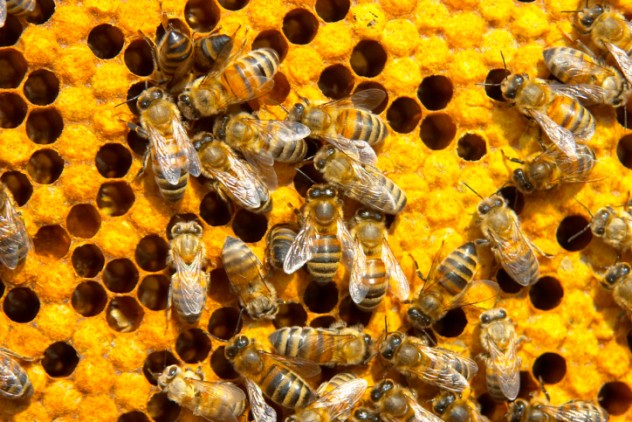
So-called “killer bees” are Africanized honeybees that look identical to the European subspecies. But whereas disturbing a European honeybee hive will almost never result in a non-allergic human’s death, disturbing a killer beehive is like playing Russian roulette, since they require very little provocation to retaliate. A lawn mower 50 meters (150 ft) away will probably not bother ordinary bees—killer bees will consider this a threat and attempt to destroy it. Most people cannot outrun a honeybee. The killer subspecies flies at 19–24 kilometers (12–15 mi) per hour and will chase you at this speed for several hundred meters. Their venom is no worse than that of any other honeybee, but they attack aggressively and en masse. Sheltering in your home will usually work, though it’s a good idea to close your windows.
This sort of nightmare happens more frequently than you might believe. About 40 people succumb to killer bee swarms per year in North America. On June 3, 2013, Larry Goodwin of Moody, Texas, bumped a derelict chicken coop with his tractor while clearing brush and 40,000 bees poured out. Goodwin attempted to outrun the bees in his tractor, but had to jump out and run to a garden hose and spray them away until his neighbors could get indoors. One woman ran to help him but was stung dozens of times and forced into her home. Volunteer firefighters could not approach with water cannons without being chased away, and Goodwin was killed.
The primary difference between Africanized honeybees and their European cousins is that when disturbed, only about 10 percent of a European hive will emerge to defend it. When killer bees attack, the percentage is far higher and the swarm becomes truly monstrous. As with any bee, each sting results in its death, since its barbed stinger tears out of its body when it flies away. Nevertheless, they are so aggressive that they will burrow under the protective clothing of a beekeeper in order to sting. No other bee is known to do this.
5 Mosquitoes That Bleed Livestock Dry
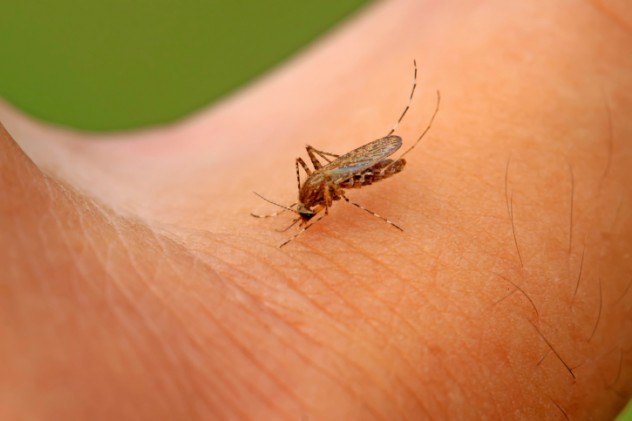
When mosquitoes swarm, the result is precisely what you would expect. They do not sting in defense like bees, but once they grow large enough, it’s easy to feel them bite you. One bite is no big deal, unless you contract malaria or another disease. They typically cannot suck much blood before an attentive person swats them away. Even a large mosquito can only hold about one drop of blood, but a swarm can contain billions, and that is what happened from August to late September 1980, on Stephen Perry’s farm outside Brazoria, Texas.
The swarm occurred when billions of mosquito eggs that had lain dormant in the nearby marshes for 20 years were flooded by saltwater tides. Saltwater was all they needed to hatch, and when they did, billions of larvae became billions of mosquitoes, attacking Perry’s livestock in unison. Perry’s cattle and horses began showing up dead around his property. Necropsies revealed no external injuries but sometimes fully half of the usual 7–9 gallons of blood was missing from the carcass. Perry stated that he could wave his hand above his head and bring down a fistful of several hundred mosquitoes. These swarms lasted, one after another, for over a month.
4 Monarch Migrations
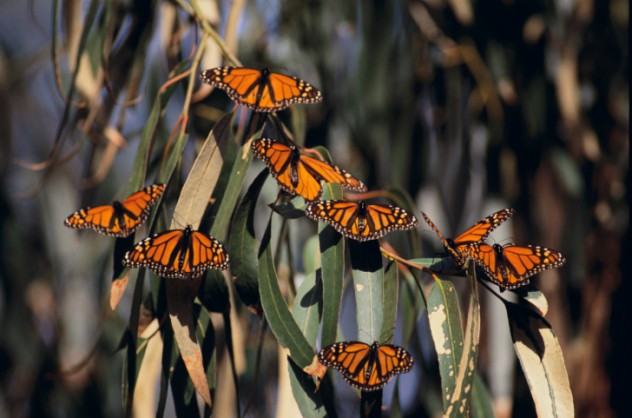
Not all swarms are terrifying—monarch butterflies, congregating in the millions, are an awe-inspiring sight. Monarchs are the only North American butterflies that migrate like birds, but they do not survive the trip. They begin flying south into Mexico from up to 4,000 kilometers (2,500 mi) away in Canada, and the females lay their eggs on the way. They die, the eggs hatch, and the new butterflies complete the trip. They are inexplicably born with the knowledge of how to do this.
Almost all of the monarch species winters in what is now conserved as the Monarch Biosphere Reserve in Mexico and Michoacan. This ecosystem is a forest of pines and oaks, covering about 138,000 acres. The monarchs confine themselves every year to about 11.6 acres within this forest. They congregate on the trees, lighting on the leaves, needles, bark, ground, and one another like bushy orange vines. When they all take flight at once, they sound like rain.
3 Albert’s Swarm
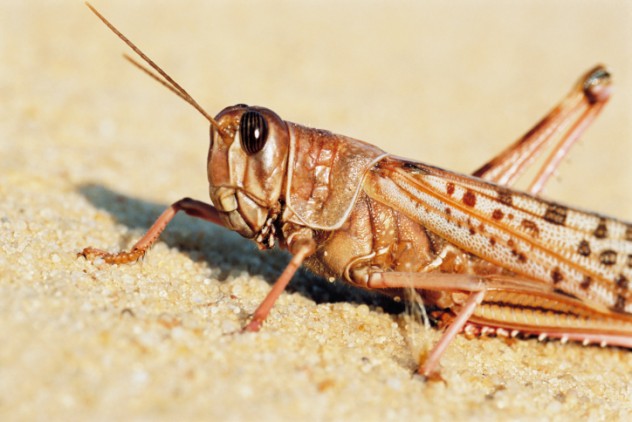
This is a single historical swarm of insects, one of the most famous ever recorded, primarily because it remains the largest known gathering of a single species of any animal in the history of our planet. The insect in question was the Rocky Mountain locust, now extinct due to the deep plowing method of farming in use at the time, which caused the Dust Bowl some 60 years later. The swarm is recorded striking western Missouri in April 1875. By then, a Nebraskan doctor named Albert Child had observed the cloud blotting out the whole daytime sky and calculated its size by means of its speed and the time it took to cross southern Nebraska according to farmer’s reports. He arrived at an estimated area of 513,000 square kilometers (198,000 sq mi), larger than California. The swarm weighed approximated 27.5 million tons, and might have numbered 12.5 trillion individuals. Like most locusts, these could not bite, but they did cause livestock to stampede and could even suffocate them by flying down their throats. They devoured every single leafy crop wherever they went.
The species became extinct around the turn of the 20th century, because its habitat was plowed over, destroying buried eggs.
2 Migration Of The Driver Ant
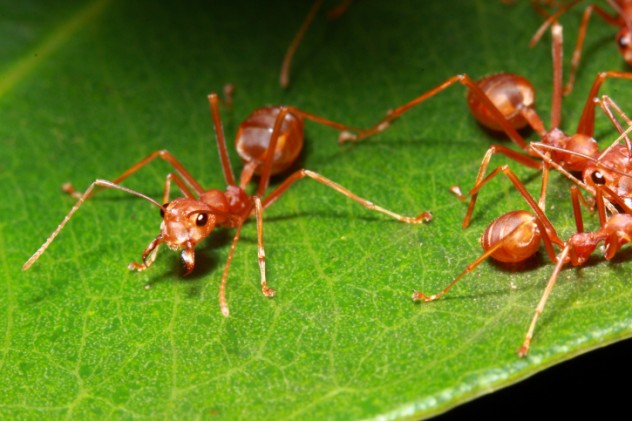
“Strength in numbers” is the marching song of the driver ant or siafu—when food becomes scarce, a colony will pick up and move. When it does, all other animals, from insects to people to elephants, vacate the area. There is no other option. These ants can cross wide, rapid rivers by floating in rolling balls. They climb trees for the food in the canopies. They have no eyes, and find their way via pheromones. Any animal that ventures too close sets off a guard ant’s alarm pheromone, and the rest of the ants swarm, surround, and devour. They kill large animals by invading their lungs. They very rarely sting, but prefer to bite with their gigantic jaws. These are the ants whose jaws African and South American natives use as stitches when needle and thread are unavailable.
Such ant migrations are rare, occurring about once every five years, but the swarming behavior occurs among almost all “army” ant species. The siafu is the most feared the world over.
In Brazil and the countries north of it, the species is Echiton burchellii. Colonies will periodically move from one home to another, and will not stop until they find a region abundant in food. During the migration, they form temporary camps made of the ants themselves, to protect the queen and eggs. The ants form living walls around them inside bushes and up trees. Anything that disturbs them is savagely attacked. E. burchellii is capable of causing pain by biting, but cannot cut into human flesh like the siafu. They can, however, attack the eyes and mucous membranes. There are over 50 siafu species, the most well-known of which is Dorylus molestus. This ant is actually welcome in many African communities, since it carries away and eats rats. The locals must give them a wide berth, as they will eat anything they can overwhelm. There is no documented evidence of them killing elephants, but the locals of the jungle nations claim to have seen it—certainly they can bite through elephant skin.
1 The Sadiya Tarantula Invasion
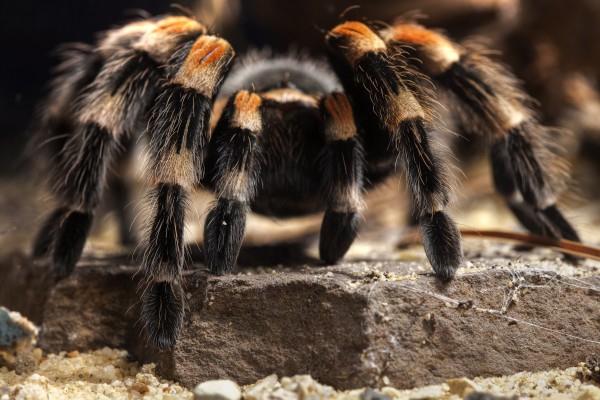
Spiders are almost always loners because they are cannibals—those of the same species may eat each other during any encounter. No spider will tolerate another’s presence near its web, nor will webless spiders tolerate being around each other. So swarming behavior is almost unheard of among their species, but on May 8, 2012, an outdoor festival in Sadiya, at the foot of the Himalayas, was crashed by what locals described as hordes of medium-size tarantulas scurrying down from the hills into the streets, up walls, and onto people.
Not much is known about the swarm, but the “highly aggressive” spiders apparently swarmed into town, jumped onto people and animals, and bit them all over. Two people were said to have died from the bites. However, they initially went to local witch doctors, who cut open their bites, drained the blood and burned it. Only when this didn’t work did the victims go to the hospital, so it is likely that their deaths were due to infection.
The swarm apparently retreated as suddenly as it arrived, because arachnologists, baffled by the gregarious spiders, swarmed into town themselves from all over the world to study the species, only to be met with an enigma. Some specimens of the mystery spider were caught and appeared to be an unknown species, perhaps a hybrid. They exhibited the viciously intemperate disposition and general build of the famously fearsome Sydney funnel-web, but the latter is not found outside Australia. Attempts to locate the origin of the swarm have so far been in vain.
Happy Halloween from FlameHorse. He had to write this list with the lights on.





